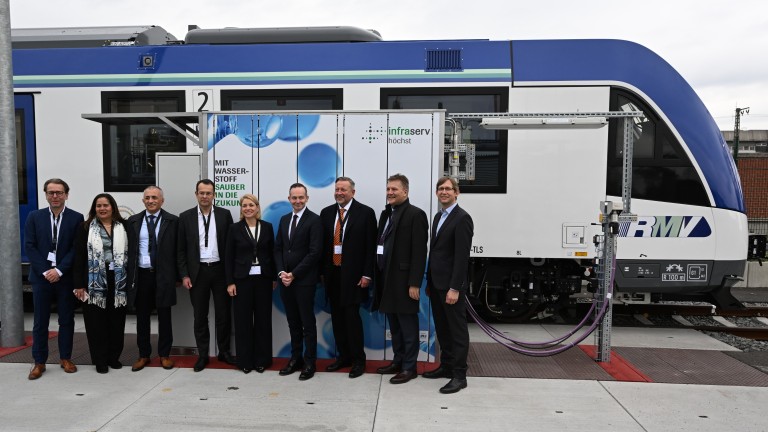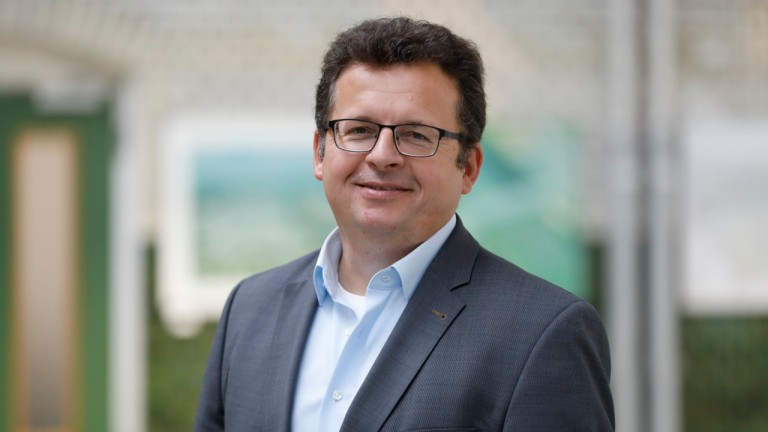15.11.2022 | Press Release
First vehicle in the world’s largest hydrogen train fleet presented in Frankfurt
Flagship project for no-pollutant mobility / Locally emissions-free with hydrogen from Industriepark Höchst

The first fuel cell-powered train to start running in the Taunus system in December was presented by the Rhine-Main Transit Association (RMV), joined by Joachim Kreysing, Managing Director of Infraserv Höchst; Volker Wissing, German Federal Minister for Transport; Jens Deutschendorf, Parliamentary State Secretary; Ulrich Krebs, Deputy Chairman of the RMV Supervisory Board; Evelyn Palla, DB Board Member; and Müslüm Yakisan, President of Alstom’s DACH Region.
The Rhine-Main Transit Association (RMV) presented the first fuel cell-powered train that will start running in the Taunus system in December. Present at the event were also Volker Wissing, German Federal Minister for Transport; Jens Deutschendorf, Parliamentary State Secretary; Ulrich Krebs, Chief Administrative Officer of Hochtaunus County and Deputy Chairman of the RMV Supervisory Board; Wolfgang Siefert, Head of Mobility for the City of Frankfurt; Evelyn Palla, Member of the Management Board of Deutsche Bahn; Müslüm Yakisan, President of Alstom’s DACH Region; and Joachim Kreysing, Managing Director of Infraserv Höchst. After the train was presented at the DB workshop in Griesheim, it was taken on a test drive to Industriepark Höchst to Infraserv Höchst’s new hydrogen filling station.
Volker Wissing, Federal Minister of Digital Affairs and Transport: “We must slash transportation emissions to reach our climate goals. That means we need new, efficient, zero-emission transportation as well as an energy system that emits no CO2. Hydrogen is part of the solution, especially for heavy commercial vehicles, ships and rail operations. With H2 technology, we will one day be able to travel quietly with no climate impact on rail lines that would cost too much to electrify. It’s a real game changer.”
Jens Deutschendorf, Parliamentary State Secretary in the Hessian Ministry for Economy, Energy, Transport and Housing: “Emission-free mobility is a core element of the energy transition. The world’s largest hydrogen train fleet is a milestone in sustainable mobility and will be operating in the Taunus system in Hesse from December onwards. This climate-friendly alternative is being tested for all routes that cannot be reasonably electrified with overhead lines. It will make local public transit quieter and more environmentally friendly than it already is. All these reasons explain why the State of Hesse has contributed more than EUR 3 million to the hydrogen filling station. However, I would also like to thank the federal government and all the partners involved in financing and rolling out this cutting-edge mobility project here in Hesse.”
“Hydrogen trains take us a big step closer to climate-neutral transportation,” said Ulrich Krebs, District Administrator of Hochtaunus County and Deputy Chairman of the RMV Supervisory Board. “In the future, not only will the routes in the Taunus network be served with emission-free hydrogen trains, but the modern locomotives will also be significantly quieter than the diesel vehicles that they are replacing. That makes us particularly pleased to be part of this innovative project.”
“Frankfurt is a transportation hub of tremendous importance. We are proud that the world’s largest hydrogen train fleet is being refueled and serviced right here in the Rhine-Main hydrogen region – a perfect fit. We have been testing hydrogen buses in local traffic in Frankfurt since this summer and have seen promising results. I am delighted that RMV is now bringing this technology to the rails,” said Wolfgang Siefert, Head of Mobility for the City of Frankfurt.
“In addition to putting the world’s largest hydrogen train fleet on the rails, we are also replacing diesel-powered trains with hydrogen vehicles in Hesse for the first time ever. After having rolled out electric trains, electric buses and hydrogen-powered buses, we’ll be giving our passengers another way to travel emission-free. This is a giant step toward our clear goal: Starting in 2030, we will only be buying vehicles that do not use diesel engines – so we can achieve pollutant-free mobility,” said Prof. Knut Ringat, Managing Director and Spokesman for the Executive Board of RMV.
Evelyn Palla, DB Board Member for Regional Transport, said, “We want to relegate fossil fuels to the history books. That is why we are embracing hydrogen as a technology of the future in order to make regional transportation emission-free. In Taunus, the future is just around the corner: Starting in December, we will be operating the world’s largest hydrogen fleet. Our passengers will then be traveling in a climate-neutral manner.”
For more than 15 years, Infraserv Höchst has been committed to technology projects that advance the use of hydrogen for sustainable, low-emission mobility and energy supply solutions. “We are extremely proud that Industriepark Höchst plays such an important part in this project as the site for new hydrogen infrastructure to supply the trains,” said Joachim Kreysing, Managing Director of Infraserv Höchst.
“Zero-emission mobility is one of the most important goals for a sustainable future, and Alstom has a clear ambition to become the world leader in alternative traction solutions for rail. The world’s first hydrogen train, the Coradia iLint, demonstrates our clear commitment to green mobility combined with state-of-the-art technology. We are very proud to put this train into large-scale operation together with such strong partners. That means the Frankfurt region will have the largest hydrogen train fleet in the world,” said Müslüm Yakisan, President of Alstom’s DACH region.
World’s first passenger train with hydrogen fuel cell traction system
ALSTOM’s Coradia iLint is the world’s first passenger train powered by a hydrogen fuel cell; the cell generates the electric power that moves the vehicle. The traction battery temporarily stores surplus electricity generated by the cell as well as energy recovered during braking. The extensively and comfortably equipped traction units are as quiet as electric traction units and locally emission-free because they only release water vapor and heat into the environment.
On four lines through the Taunus Mountains
In December, the first vehicles in the 27-train fleet will begin running in the Taunus system, starting on the RB15 line. The other vehicles will be delivered over the winter and placed into service in phases. The Taunus system comprises four lines, some of which have not been electrified:
- RB11 (Frankfurt-Höchst – Bad Soden)
- RB12 (Frankfurt – Königstein)
- RB15 (Frankfurt – Brandoberndorf)
- RB16 (Bad Homburg – Friedberg)
The lines are operated by Regionalverkehre Start Deutschland GmbH (“start”). This wholly owned Deutsche Bahn subsidiary, which successfully operates two other regional rail systems in northern Germany, prevailed in a Europe-wide tender and will replace the previous operator, Hessische Landesbahn GmbH (HLB), in December. However, HLB will temporarily continue to operate the RB11 and RB16 lines until the end of April so that the Taunus system can continue operating at full capacity until all the hydrogen trains have been delivered. This is an extraordinary commitment that serves passengers’ best interests.
Alstom is responsible for the maintenance of these vehicles and thus for their availability and reliability over their entire service life. DB Regio is doing the work on Alston’s behalf at the Deutsche Bahn workshop in Griesheim.
The vehicles were procured through Fahrzeugmanagement Region Frankfurt Rhein Main GmbH (“fahma”), a wholly owned subsidiary of RMV. The project volume is around EUR 500 million over 25 years for vehicle procurement, maintenance and operation.
Infraserv Höchst, the company that operates Industriepark Höchst, has built hydrogen storage and compression facilities in addition to the actual refueling station. It has also expanded the rail tracks at the industrial park. Another important part of the project is the construction of an electrolyzer for hydrogen production. Hydrogen has long been produced at Industriepark Höchst as a byproduct of production processes.
The German federal government is financing 40 percent, but no more than EUR 14.7 million, of the additional costs of procuring these vehicles compared to conventional diesel vehicles. It is thus supporting RMV in its effort to buy vehicles that use alternative traction technologies. The government is also directly funding the construction of the hydrogen filling station at Industriepark Höchst. It has contributed a total of EUR 24.3 million toward the project.
The State of Hesse is supporting the construction of basic rail infrastructure for the hydrogen filling station by contributing around EUR 2.5 million, or just under 60 percent of the costs. Another EUR 800,000 was spent on preparatory appraisals and a mobile train refueling station.

